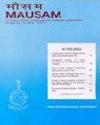通过在旁遮普邦 NICRA 采纳的村庄采用农业气象咨询公告 (AAB),在作物种植中减缓气候变化并进行风险管理
IF 0.7
4区 地球科学
Q4 METEOROLOGY & ATMOSPHERIC SCIENCES
引用次数: 0
摘要
农作物产量是可管理(农艺)和不可管理(天气)投入的直接产出。农民可以通过关注天气预报来减少因异常天气条件造成的作物生产损失。印度气象局在县和区一级提供八个天气参数的天气预报。在全印度农业气象学协调研究项目--国家气候适应性农业创新项目下,利用未来五天的天气预报编制农业气象咨询公告(AAB),并分发给农民。为了评估 AAB 在三个选定村庄 Badoshe Kalan 和 Bauranga Zer(Fatehgarh Sahib 县)以及 Rampur Fasse(Rupnagar 县)的影响,对 110 名农民进行了调查。在 110 位农民中,有 70 位边缘/小农户(土地面积小于 2.0 公顷)和 40 位中等农户(土地面积 2-10 公顷)在作物栽培中采用了《农作 物评估与分析》中提供的信息。分析表明,在水稻和小麦作物种植过程中,65-93% 的农民通过生物胁迫管理获益,65-85% 的农民通过灌溉管理获益,75-78% 的农民通过调整播种获益,62-65% 的农民通过养分管理获益。在水稻-小麦种植系统中采用人工辅助灌溉安排作物灌溉的农民通过避免浪费柴油减少了约 34.2 公吨的二氧化碳排放量。在水稻和小麦作物中采用自动喷灌技术的农户能够分别获得 2.25-3.75q/ha 和 1.75-4.50q/ha 的平均增产,并以较少的支出分别节省近 4100-7000 卢比/公顷和 3200-9200 卢比/公顷。因此,AAB 不仅有助于提高作物产量,还有助于减少碳足迹,使农业成为生态友好型的盈利项目。本文章由计算机程序翻译,如有差异,请以英文原文为准。
Mitigation and risk management of climate change in crop cultivation through the adoption of Agromet Advisory Bulletin (AAB) in NICRA adopted villages in Punjab
Crop production is a direct output of manageable (agronomic) and unmanageable (weather) inputs. A farmer can cut down losses in crop production due to aberrant weather conditions by following weather forecast. India Meteorological Department is providing weather forecast on eight weather parameters at district and block level. Under All India Coordinated Research Project on Agrometeorology-National Innovations in Climate Resilient Agriculture, an Agromet Advisory Bulletin (AAB) is prepared by using this forecast for coming five days and disseminated to farmers. To evaluate the impact of AAB in three selected villages Badoshe Kalan and Bauranga Zer (district Fatehgarh Sahib) and Rampur Fasse (district Rupnagar) a survey from 110 farmers was conducted. Amongst the 110 farmer, 70 were marginal/small farmers (landholding <2.0ha) and 40 were medium farmers (landholding 2-10ha) who adopted the information given in AAB in crop cultivation. The analysis revealed that by following AAB in rice and wheat crops 65-93% farmers benefitted by managing biotic stresses, 65-85% farmers by irrigation management, 75-78% farmers by adjusting sowing and 62-65% farmers by nutrient management. The farmers who scheduled irrigations to their crop by adopting AAB in rice-wheat cropping system reduced ~34.2 metric tonnes of CO2 emissions by preventing wasteful burning of diesel. The adopters of AAB in rice and wheat crop were able to harness an average yield increase of 2.25-3.75q/ha and 1.75-4.50 q/ha, respectively and save nearly Rs 4100 to 7000/ha and Rs 3200-9200/ha, respectively with lesser expenditure. Hence, AAB can help boost crop productivity as well as help reduce carbon footprints and make agriculture an eco-friendly and profitable venture.
求助全文
通过发布文献求助,成功后即可免费获取论文全文。
去求助
来源期刊

MAUSAM
地学-气象与大气科学
CiteScore
1.20
自引率
0.00%
发文量
1298
审稿时长
6-12 weeks
期刊介绍:
MAUSAM (Formerly Indian Journal of Meteorology, Hydrology & Geophysics), established in January 1950, is the quarterly research
journal brought out by the India Meteorological Department (IMD). MAUSAM is a medium for publication of original scientific
research work. MAUSAM is a premier scientific research journal published in this part of the world in the fields of Meteorology,
Hydrology & Geophysics. The four issues appear in January, April, July & October.
 求助内容:
求助内容: 应助结果提醒方式:
应助结果提醒方式:


